Picture this common scenario: A basketball player earns first-team all-state honors after an outstanding senior season. The school celebrates with social media posts and announcements, but within weeks, the achievement fades from view. A small nameplate eventually appears in an overcrowded trophy case, squeezed between dozens of other recognitions where hardly anyone pauses to look. Years of dedication and elite performance reduced to a 2-inch plaque that freshmen athletes never notice, prospective families never discover during campus tours, and even the athlete’s own family struggles to find when they visit.
This scenario plays out in schools across the country every season. All-state athletes—representing the absolute pinnacle of high school athletic achievement—receive recognition that fails to match the magnitude of their accomplishment. Traditional trophy cases and physical plaques simply cannot provide the visibility, engagement, and lasting impact that these extraordinary achievements deserve.
Touch board technology revolutionizes all-state recognition by creating interactive experiences that students actively explore, comprehensive profiles that tell complete achievement stories, unlimited recognition capacity that never requires choosing what to display, and instant updates that celebrate athletes immediately upon selection. These modern recognition systems honor past excellence while inspiring current athletes to pursue similar achievement, creating cultures of athletic excellence that compound across generations.
Understanding Touch Board Technology for All-State Recognition
Before exploring implementation strategies, understanding what touch board technology offers and why it surpasses traditional recognition methods provides essential context for effective planning.
What Is a Touch Board Recognition Display?
A touch board recognition display combines commercial-grade touchscreen hardware with specialized software designed specifically for celebrating achievements. Unlike generic digital signage that simply rotates static images, true touch board systems enable active interaction through intuitive touchscreen navigation allowing users to explore content at their own pace, powerful search functionality helping visitors quickly find specific athletes or achievements, rich multimedia integration incorporating photos, videos, statistics, and comprehensive profiles, and dynamic content management enabling real-time updates without technical expertise.
The “touch” aspect is fundamental—these systems transform recognition from passive viewing into active exploration. Students don’t simply glance at names on a wall; they interact with comprehensive achievement profiles, search for athletes in their sport, compare statistics across eras, watch highlight videos, and discover inspirational stories that motivate their own pursuit of excellence.
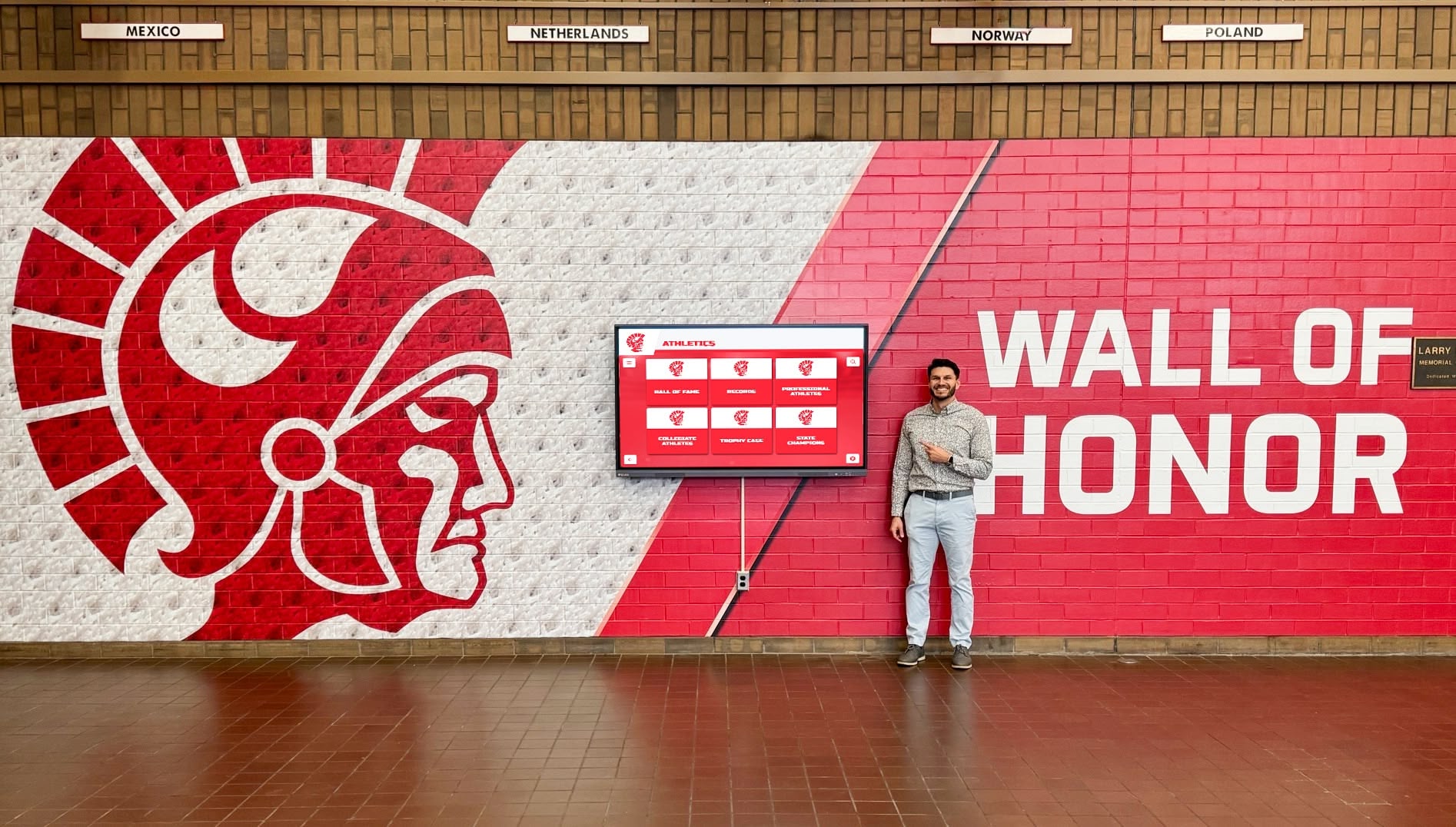
Why Touch Boards Excel for All-State Recognition
Touch board systems address every fundamental limitation that prevents traditional recognition methods from providing the celebration elite athletes deserve:
Unlimited Recognition Capacity
Physical trophy cases face severe space constraints that force difficult decisions about which achievements receive display prominence. Touch boards eliminate this limitation entirely. Schools can recognize every all-state athlete in program history—from recent selections to athletes from decades past—without competing for limited space. Each athlete receives comprehensive profile space impossible with traditional plaques, and adding new honorees requires no additional physical space or hardware investment.
Instant Updates and Timeliness
Traditional recognition requires ordering plaques, scheduling installation, and waiting weeks or months before new all-state athletes appear in school displays. This delay dramatically reduces recognition impact by allowing initial excitement to fade before visible celebration occurs. Touch boards enable immediate updates—schools can publish comprehensive all-state athlete profiles within minutes of selection announcements, honoring achievement while attention and enthusiasm remain at peak levels.
Rich Multimedia Storytelling
A 2-inch plaque listing name, sport, and year communicates basic facts but misses opportunities to tell the complete stories behind all-state achievement. Touch boards transform recognition into compelling narratives featuring professional photography from competitions, video highlights of standout performances, complete career statistics and achievement documentation, quotes from athletes reflecting on their journey, coach testimonials providing context and perspective, and information about college commitments and continuing careers. This depth creates emotional connections and provides inspirational context that plaques and brief mentions cannot match.
Interactive Exploration and Discovery
Traditional displays require viewers to scan every name hoping to find specific athletes or relevant information. Touch boards enable intuitive exploration through searchable databases finding athletes instantly by name, filterable content showing only specific sports or years, comparison tools examining statistics across different eras, related content connections introducing visitors to similar achievements, and bookmarking capabilities allowing visitors to save and return to favorite profiles. This interactivity increases engagement time dramatically—visitors typically spend 3-5 minutes exploring well-designed touch board displays compared to brief glances at traditional trophy cases.
Accessibility Beyond Physical Location
Trophy cases and physical plaques require campus presence to view. Touch boards extend recognition through web-based versions accessible from anywhere with internet access, mobile applications bringing recognition to smartphones and tablets, social sharing capabilities allowing achievement celebration across networks, alumni access enabling graduates to show families their recognition regardless of location, and recruiting platforms helping college coaches research program excellence remotely. This accessibility multiplies recognition impact exponentially beyond what traditional physical displays can achieve.
Many schools discover that comprehensive all-state athlete recognition displays become centerpieces of their athletic programs, fundamentally transforming how communities celebrate excellence.
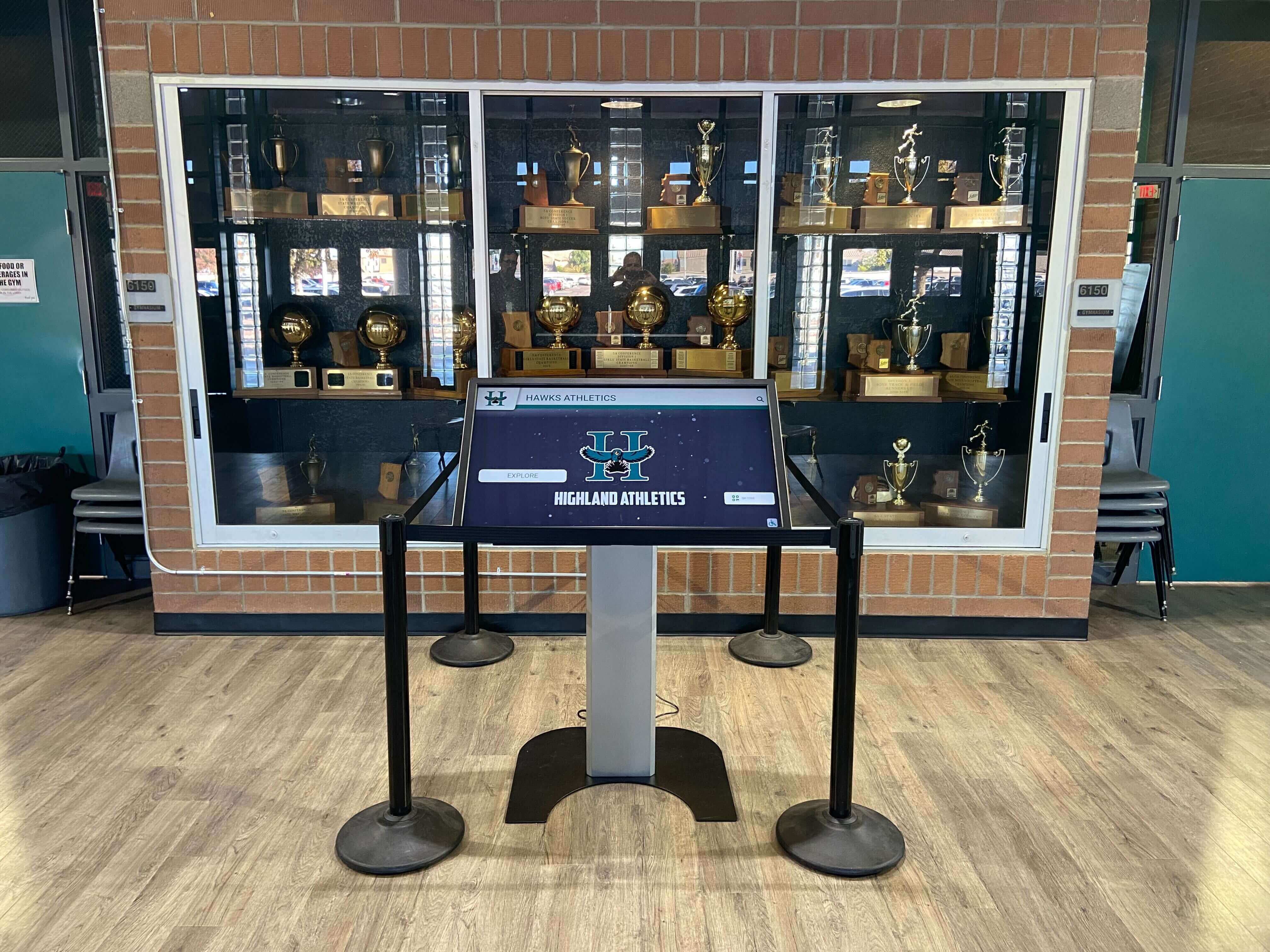
Planning Your Touch Board All-State Recognition System
Successful implementation begins with strategic planning that ensures recognition systems meet your school’s specific needs while serving diverse stakeholders effectively.
Defining Recognition Goals and Objectives
Clear goals guide every subsequent decision about technology selection, content development, and implementation approaches.
Honoring Individual Achievement
The primary objective of all-state recognition is celebrating individual athletes who achieved elite performance levels. Consider how your recognition will comprehensively document each athlete’s accomplishment, provide appropriate depth reflecting achievement significance, maintain permanent records preserving legacy indefinitely, and honor all athletes fairly regardless of sport profile or competitive era.
Inspiring Current and Future Athletes
Recognition serves not only past achievement but future motivation. Effective systems demonstrate pathways to excellence showing underclassmen how prior athletes reached all-state levels, establish aspirational targets with concrete examples of what’s possible within your program, communicate performance expectations through statistical benchmarks and achievement patterns, and celebrate program traditions showing sustained excellence across generations.
Building Program Reputation
Visible all-state recognition demonstrates athletic program quality to important external audiences. Strategic recognition attracts talented youth athletes during school selection decisions, impresses prospective families evaluating overall school quality, engages college recruiters researching program excellence, and strengthens community pride in athletic achievement.
Preserving Institutional History
Recognition creates permanent institutional memory that would otherwise fade as personnel change and memories blur. Comprehensive systems document complete program history across decades or centuries, maintain accurate records preventing disputes about historical achievements, preserve media and documentation that physical archives lose over time, and connect current achievements to longer traditions of excellence.
Conducting All-State Research and Documentation
Before implementing recognition systems, thoroughly research and document all-state athletes from your program’s history.
Historical Research Strategies
Identifying all-state athletes from past decades requires systematic investigation across multiple sources:
Begin with existing athletic department records including coaching files, media guides, and award documentation. Review yearbooks comprehensively as many include all-state recognition in sports sections or senior profiles. Search local newspaper archives—many libraries maintain digital archives of community newspapers that announced all-state selections. Interview longtime coaches, athletic directors, and community members who recall historical all-state athletes. Contact alumni associations for assistance identifying and connecting with all-state athletes who might contribute information and media. Examine trophy cases and physical displays documenting past recognition.
Many schools discover that comprehensive all-state athlete research uncovers forgotten achievements while building enthusiasm among alumni excited to contribute to recognition efforts.
Information Collection Systems
Develop standardized processes for documenting current and future all-state athletes immediately upon selection:
Create submission forms for athletes and families providing biographical details, career statistics, memorable moments, personal quotes and reflections, and media release permissions. Assign specific staff responsibility for photography during competitions and recognition events. Establish timelines ensuring new all-state athletes appear in recognition displays within days of selection announcements. Implement verification procedures confirming accuracy before publication—nothing undermines recognition credibility faster than factual errors in athlete profiles.

Prioritization for Phased Implementation
When documenting decades of all-state athletes, prioritize comprehensiveness for recent athletes while building historical depth over time:
Begin with detailed profiles for athletes from the past 5-10 years where information and media are readily available. This creates immediate impact and value while demonstrating commitment to recognition. Systematically expand backward through program history, adding decade-by-decade content as research uncovers athletes and materials. Accept that some historical details may remain unknown and document what you can verify rather than waiting for perfect information that may never materialize.
Budgeting for Touch Board Recognition Systems
Developing realistic budgets accounting for both initial implementation and ongoing operational costs ensures sustainable recognition programs.
Initial Investment Components
Comprehensive touch board recognition systems typically require investment in several key areas:
Commercial-grade touchscreen hardware designed for continuous operation in public spaces typically costs $3,000-$8,000 depending on screen size (55-75 inches most common) and mounting requirements. Specialized recognition software platforms with content management capabilities, multimedia support, and web accessibility usually range $2,000-$5,000 for initial licensing and setup. Professional installation including mounting, electrical work, and network connectivity typically runs $1,000-$3,000 depending on facility complexity. Initial content development creating comprehensive profiles for existing all-state athletes often represents significant investment ranging from several hundred to several thousand dollars depending on historical depth and media quality.
Total initial investment typically ranges from $10,000-$25,000 for comprehensive single-display implementations, with additional displays in multiple locations adding hardware and installation costs while leveraging shared software platforms.
Ongoing Operational Costs
Beyond initial implementation, sustaining recognition requires annual operational investment:
Software licensing and maintenance typically costs $1,000-$2,500 annually for updates, technical support, cloud hosting, and platform improvements. Content development adding new all-state athletes and updating existing profiles requires minimal ongoing cost if handled internally, or several hundred dollars annually if using professional services. Hardware maintenance and occasional replacement represents long-term consideration—commercial displays typically last 5-7 years before requiring replacement, which should be budgeted accordingly.
Funding Sources and Strategies
Many schools successfully fund touch board recognition through diverse sources beyond athletic department budgets:
Athletic booster clubs often enthusiastically support recognition investments that celebrate program excellence and attract future athletes. Alumni donations—particularly from former all-state athletes—provide natural funding sources for recognition honoring their achievements. Corporate sponsorships from local businesses seeking community visibility offer partnership opportunities. Capital campaigns focused on facility improvements can include recognition technology. Grants from foundations supporting educational technology or youth development sometimes fund recognition investments when applications emphasize developmental and motivational benefits.
Implementing Touch Board Recognition: Technology and Content
Moving from planning to implementation requires selecting appropriate technology platforms and developing compelling content that truly honors all-state achievement.
Selecting Touch Board Hardware and Software
Choose commercial solutions designed specifically for recognition rather than attempting to adapt consumer technology or generic digital signage to this specialized purpose.
Hardware Selection Criteria
Invest in commercial-grade touchscreen displays meeting these essential specifications:
Screen size appropriate for viewing distance and location—55-65 inch displays work well for entrance lobbies and corridors, while 75+ inch screens suit large commons areas or gymnasiums where viewing distance is greater. Commercial durability rated for 16-24 hour daily operation rather than consumer displays designed for home use. Responsive multi-touch technology supporting intuitive interaction without lag or frustration. Appropriate brightness for ambient lighting conditions—high-brightness displays (450-700 nits) for locations with significant natural light. Mounting flexibility supporting wall-mounted or freestanding kiosk configurations based on facility requirements.
Work with vendors experienced in educational installations who understand unique requirements of school athletic facilities, including security considerations, network integration, and maintenance support.
Software Platform Requirements
Select recognition software platforms offering these essential capabilities:
Intuitive content management requiring no technical expertise—athletic directors or coaches should be able to add new all-state athletes within minutes using simple web-based interfaces. Flexible templates designed specifically for athletic recognition optimized for all-state athlete profiles. Robust multimedia support handling photos, videos, documents, and interactive elements seamlessly. Searchable databases with filtering by sport, year, achievement level, and custom criteria. Mobile-responsive web versions extending recognition access beyond physical displays. Analytics tracking engagement, popular content, search patterns, and usage trends. White-label options allowing complete branding with school colors, logos, and identity.
Specialized platforms like those from Rocket Alumni Solutions provide turnkey solutions optimized for school recognition needs, eliminating the customization work required by general-purpose alternatives.
Comprehensive resources on selecting touchscreen kiosk software can guide evaluation and decision-making for schools comparing platform options.
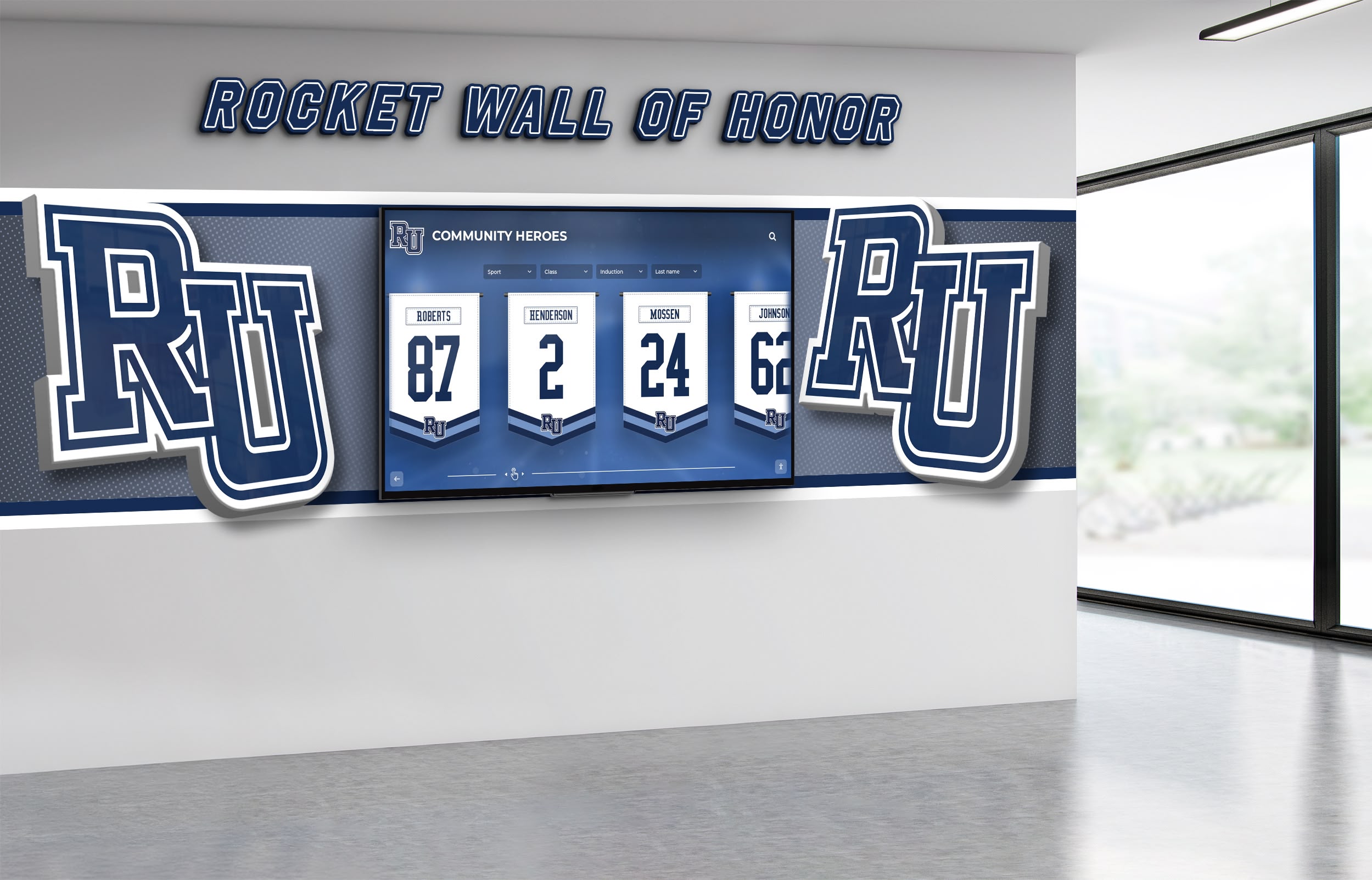
Installation Location Strategy
Strategic placement ensures maximum visibility and usage of touch board recognition displays:
Athletic facility entrances including gymnasiums, field houses, and sports complexes represent natural locations where athletes spend significant time and visitors form first impressions of program quality. Main school entrances guarantee exposure for current students, prospective families touring campuses, and community members attending events. Commons areas and cafeterias provide extended viewing opportunities during breaks and lunch periods when students have time to explore content. For comprehensive programs, consider multiple displays in different locations featuring sport-specific content relevant to each facility.
Ensure selected locations have adequate electrical power and network connectivity, working closely with facilities and IT departments during site evaluation. Consider security—displays should be visible but positioned where supervision and monitoring prevent vandalism or damage.
Creating Compelling All-State Athlete Profiles
The quality and depth of all-state athlete profiles directly determine how effectively recognition inspires current students and preserves achievement for future generations.
Essential Profile Components
Comprehensive profiles begin with complete biographical information providing context about each athlete including full name, graduation year, sport and position, all-state honors earned with specific team level (first team, second team, honorable mention), and additional recognition received (conference player of the year, state player of the year, all-American honors).
Document the athlete’s high school career arc showing progression from freshman through senior years, emphasizing development and improvement that enabled elite performance. Include specific statistical achievements that earned all-state honors—career and single-season statistics in relevant categories, school records held or approached, team achievements during the athlete’s tenure (championships, playoff appearances, winning records), and performance in high-stakes competitions like conference championships or state tournaments.
High-Quality Visual Content
Professional photography brings all-state profiles to life and creates visceral connections with recognized athletes:
Include multiple action photos showing athletes in competition demonstrating their skills and intensity. Feature team celebration photos capturing memorable moments and emotional connections. Document awards ceremony images from all-state recognition events. Include portrait photography in uniform showing pride in achievement. When available, show progression photos illustrating development from underclassmen through senior seasons.
Investment in quality photography demonstrates that all-state achievement matters and deserves professional documentation befitting its significance. Assign specific staff or student media programs responsibility for capturing high-quality content during competitions and recognition events, or budget for professional photography services documenting significant all-state athletes.
Personal Narratives and Quotes
First-person perspectives transform recognition from sterile statistics into inspiring human stories:
Feature quotes from athletes themselves reflecting on their journey, challenges overcome, meaningful moments, what all-state recognition meant to them, and advice for current athletes pursuing similar excellence. Include coach commentary providing context about the athlete’s work ethic, leadership, character, and impact beyond statistics. Add parent or family perspectives highlighting support systems behind athletic achievement and pride these honors created for families and communities.
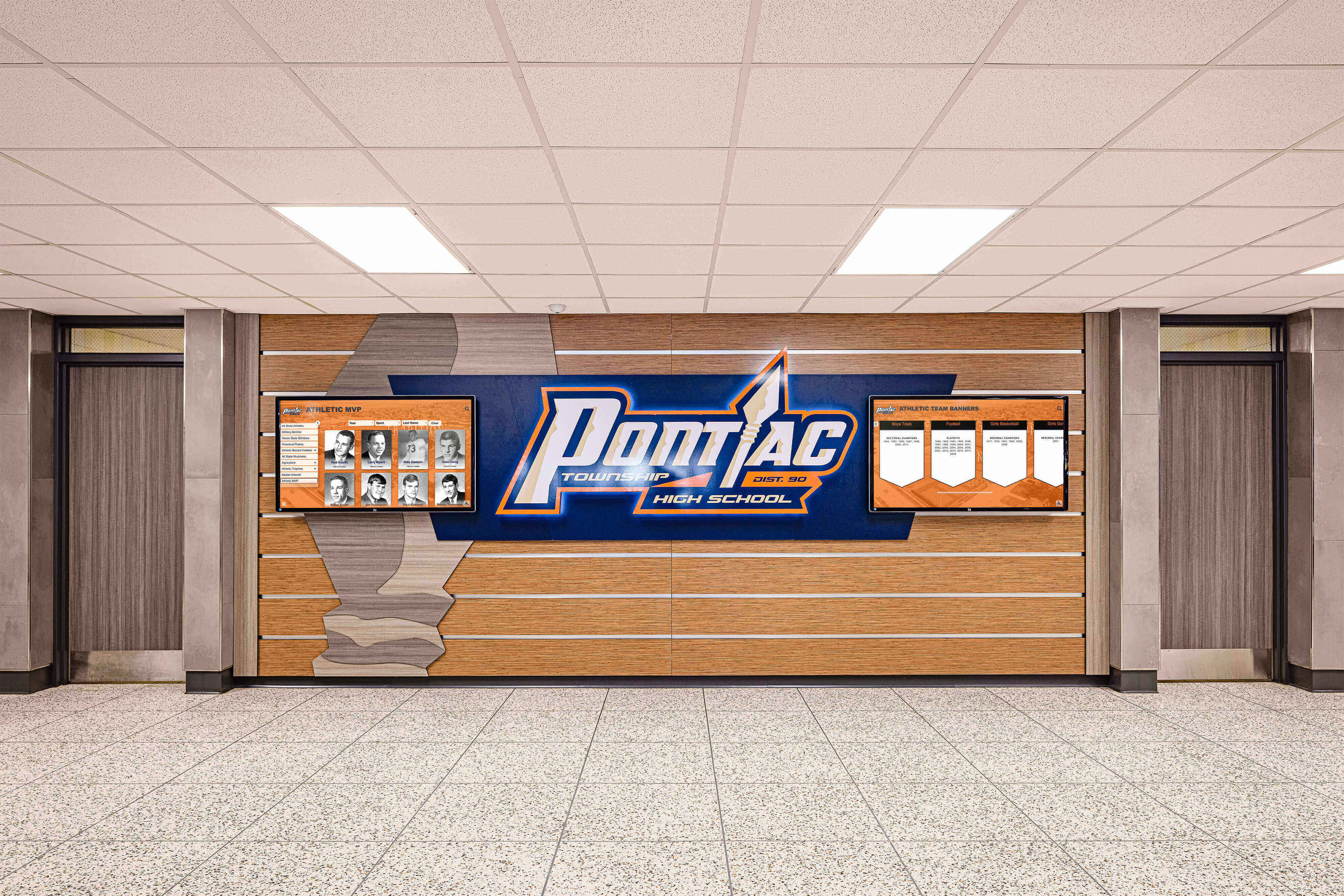
Video Integration
Video content creates engagement and emotional impact that static images cannot match:
Consider including highlight reels showing the athlete’s best performances and most impressive plays. Document game-winning moments captured on video demonstrating clutch performance under pressure. Feature interview segments with athletes discussing their experience and offering advice to younger athletes. Create documentary-style features providing comprehensive looks at the athlete’s journey from freshman to all-state selection.
Video content particularly resonates with younger athletes who consume media primarily through video platforms, making recognition displays more engaging for target audiences.
College and Career Connections
All-state recognition often leads to college athletic opportunities that deserve documentation:
Include information about college athletic commitments and recruitment. Document college athletic careers and achievements when alumni provide updates. Highlight academic and career success following athletics. Feature reflections on how high school all-state experience influenced development and future opportunities.
These follow-up elements demonstrate that all-state achievement represents not just an endpoint but a foundation for continued success, making recognition more meaningful and aspirational for current athletes.
Many programs integrate all-state recognition with college commitment celebration displays, creating comprehensive pathways showing progression from high school excellence to collegiate opportunities.
Integrating Touch Boards With Comprehensive Athletic Recognition
All-state recognition delivers maximum value when integrated within broader athletic recognition ecosystems celebrating diverse excellence across programs.
Connecting All-State Recognition to Record Board Systems
Rather than creating isolated all-state displays, integrate this recognition within comprehensive digital record board systems that showcase:
School records and statistical achievements across all sports. Championship teams and tournament success throughout program history. Individual awards and special honors beyond all-state selection. Academic all-conference and scholar-athlete recognition. Coaching milestones and program leadership. Historical traditions spanning decades or centuries.
This integration creates complete pictures of athletic excellence demonstrating how all-state athletes fit within broader program achievement and tradition. Schools implementing sport-specific digital record boards find that comprehensive systems provide context and depth that isolated recognition cannot achieve.
Multi-Sport Recognition Strategies
Ensure equitable recognition across all athletic programs regardless of sport profile or competitive success:
Feature all-state athletes from every sport your school offers, including lower-profile sports that may receive less media attention. Document excellence in both traditional and emerging sports. Celebrate both team sport athletes and individual sport competitors. Acknowledge all-state recognition across different classification levels or competitive divisions. This comprehensive approach communicates that all-state achievement in any sport represents exceptional accomplishment worthy of equal celebration, building inclusive athletic culture valuing diverse excellence.
Sport-Specific Content Organization
Organize touch board content supporting both comprehensive browsing and sport-specific exploration:
Create homepage interfaces showcasing recent all-state athletes across all sports while enabling filtering by specific sports. Develop sport-specific sections featuring all-state athletes in particular activities with relevant context about sport history and program excellence. Include comparative statistics and achievements specific to each sport’s unique metrics and recognition patterns. Feature sport-specific traditions, rivalries, and historical contexts that make achievements meaningful within particular athletic communities.
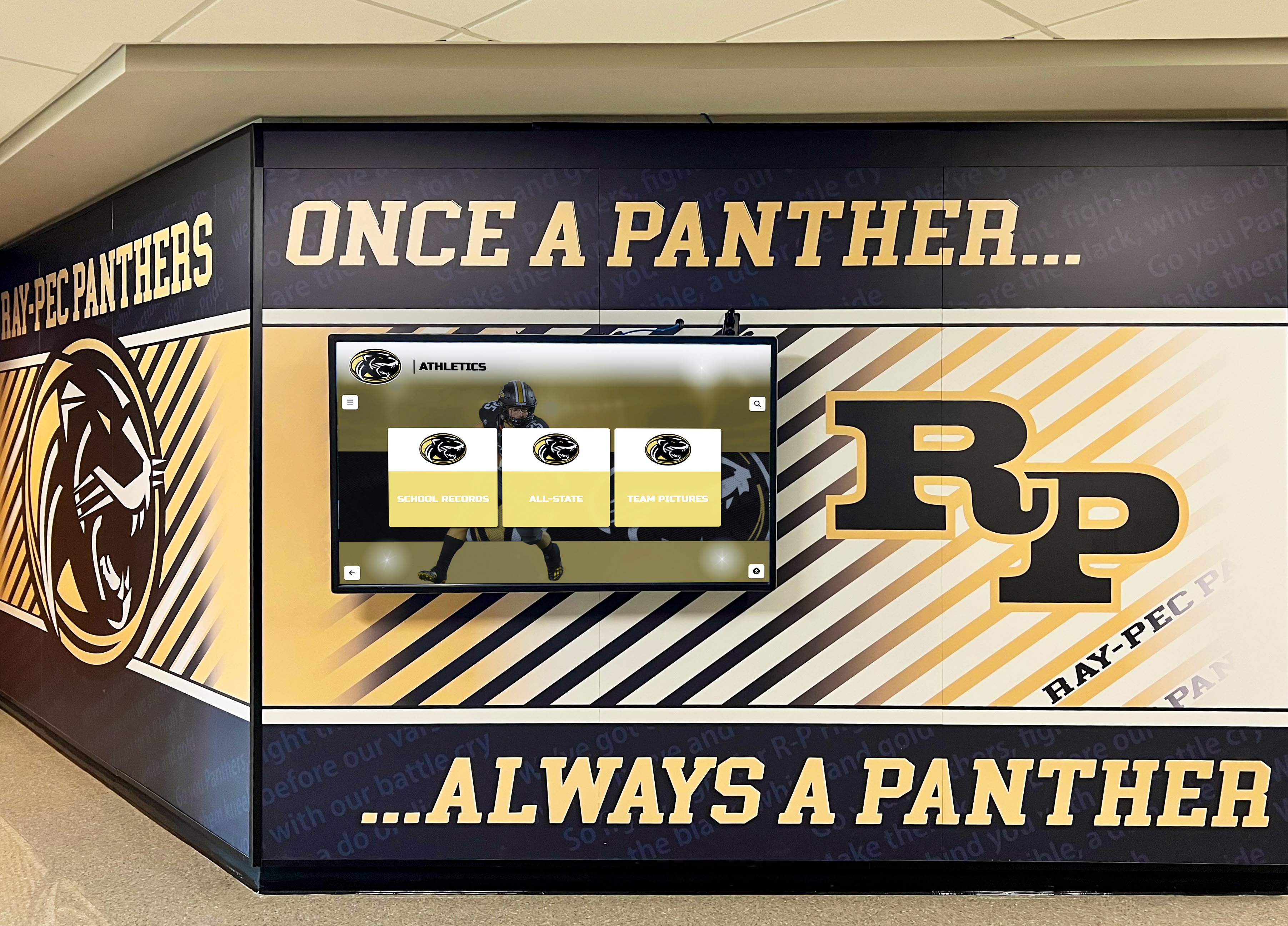
Complementary Recognition Programs
Integrate all-state recognition with related celebration programs creating comprehensive athletic excellence ecosystems:
All-star and all-conference achievement recognition documenting honors at regional and conference levels. Hall of fame inductions celebrating legendary athletes and contributors who shaped program history. Student-athlete of the week programs providing regular recognition opportunities throughout seasons. Academic achievement recognition honoring scholar-athletes excelling in classrooms and competition. Alumni career success showcasing professional and personal accomplishments following graduation.
These connections demonstrate how all-state achievement often represents one milestone within larger stories of sustained excellence across multiple domains.
Supporting Athlete Development and Motivation
Leverage all-state recognition strategically to support athlete development and motivation:
Create goal-setting programs helping athletes understand pathways to all-state consideration, including specific statistical benchmarks, skill development priorities, and competitive preparation. Provide performance tracking showing athletes’ progress toward benchmarks associated with all-state performance in their sports. Offer mentorship connections linking current athletes with all-state alumni from similar sports and positions who can provide guidance and inspiration. Highlight the work ethic, training regimens, and dedication required for all-state achievement beyond natural talent—celebrating effort and discipline alongside results.
Recognition becomes not just celebration of past achievement but inspiration and roadmap for current athletes pursuing similar excellence.
Best Practices for Touch Board All-State Recognition
Schools that have successfully implemented touch board all-state recognition share common approaches and lessons learned that can guide your planning and implementation.
Start Comprehensive But Launch Iteratively
Rather than waiting to document every historical all-state athlete before launching recognition displays, begin with comprehensive recent content and expand historical coverage over time:
Launch with detailed profiles for athletes from the past decade where information and media are readily available. This creates immediate impact and value while demonstrating commitment to recognition. Systematically add historical content on regular schedules, working backward through program history as research uncovers athletes and materials. This iterative approach delivers value quickly while building toward comprehensive coverage over time rather than delaying launch indefinitely pursuing impossible perfection.
Celebrate Broadly While Highlighting Excellence
Balance comprehensive recognition of all athletes earning any level of all-state honors with special emphasis on first-team selections and athletes earning multiple all-state honors across seasons:
Feature every all-state athlete regardless of team level or honorable mention status, demonstrating that all recognition represents exceptional achievement. Create hierarchical presentation subtly emphasizing first-team athletes and multiple-time honorees without diminishing others’ accomplishments. Celebrate sport-specific all-state athletes with equal prominence across all athletic programs rather than disproportionately featuring high-profile sports like football and basketball while neglecting others.
Maintain Currency Through Established Workflows
Success depends on sustainable processes maintaining content currency year after year:
Assign specific staff responsibility for recognition updates integrated into existing job descriptions rather than relying on volunteer efforts that fade over time. Create simple submission processes for coaches providing athlete information and media immediately upon all-state selection announcements. Establish annual review cycles verifying all information remains accurate and comprehensive. Schedule regular recognition celebration events maintaining community awareness and engagement with displays.
These sustainable workflows prevent recognition from becoming outdated and irrelevant—one of the most common pitfalls schools face after enthusiastic launches.
Engage Alumni as Recognition Partners
All-state alumni represent valuable partners for recognition programs:
Invite alumni to contribute historical information, photos, and media about their careers and teammates. Request alumni updates about college athletic careers, academic achievements, and professional accomplishments enriching existing profiles. Feature alumni mentor opportunities connecting current athletes pursuing all-state goals with alumni who achieved these honors. Acknowledge alumni contributions to recognition programs reinforcing their ongoing importance to athletic tradition.
This engagement transforms passive recognition recipients into active recognition program supporters who help sustain and improve systems over time.
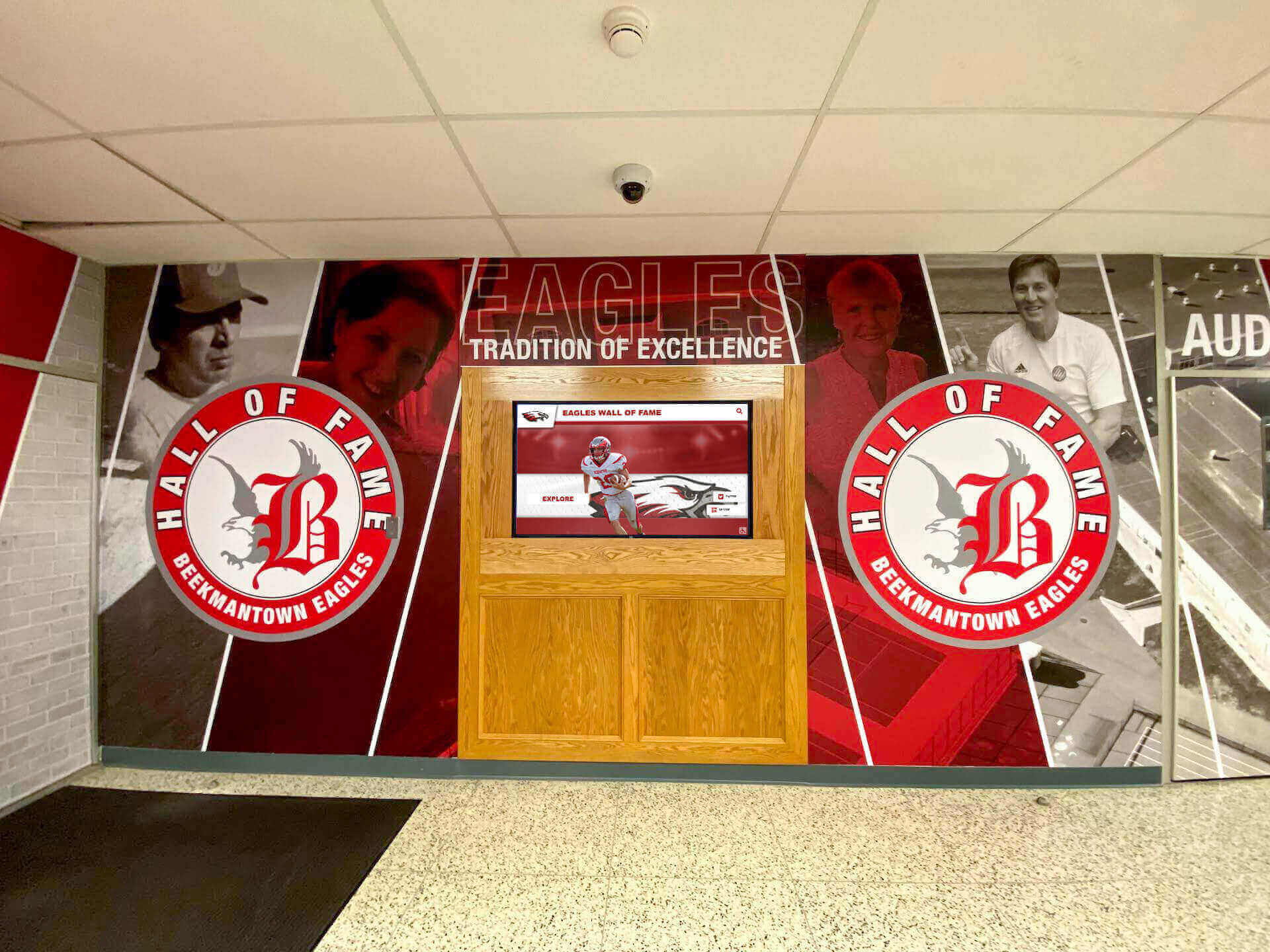
Integrate Recognition With Broader Communications
Extend recognition impact beyond physical displays through integrated communication strategies:
Feature new all-state athlete profiles through school social media channels when athletes appear in recognition displays. Include all-state recognition updates in athletic department newsletters and alumni communications. Create social media content encouraging visitors to explore recognition displays when attending athletic events. Generate website content embedding digital recognition profiles that attract organic search traffic from families researching school athletic programs.
This multichannel approach multiplies recognition reach far beyond those physically viewing touch board displays, creating comprehensive celebration that honors achievement through every available channel.
Measuring Touch Board Recognition Success
Effective recognition programs assess impact through quantitative and qualitative measures demonstrating return on investment and informing continuous improvement.
Engagement Metrics and Analytics
Track touch board usage and engagement patterns using built-in analytics capabilities:
Monitor daily and monthly interaction counts showing how many people engage with recognition content. Measure average session duration indicating depth of engagement—are visitors spending 30 seconds or 5 minutes exploring? Identify most-viewed all-state athlete profiles revealing which content resonates most strongly. Analyze search queries demonstrating how visitors explore recognition databases and what information they seek. Track peak usage times informing optimal update scheduling and content refresh cycles. Measure return visitor percentage showing sustained interest versus one-time viewing.
Growing engagement over time validates recognition investment and identifies opportunities for content enhancement that increases usage and impact.
Athlete and Student Feedback
Systematically gather input from athletes about recognition impact:
Survey current athletes about awareness of all-state recognition displays and whether displays influenced their goals and motivation. Ask all-state athletes whether recognition felt meaningful and appropriately honored their achievement. Conduct focus groups with underclassmen exploring how they perceive all-state achievement and whether recognition makes these accomplishments seem attainable versus impossibly distant. Monitor social media engagement with recognition content shared by athletes and families, noting both quantity and sentiment of responses.
This feedback reveals whether recognition achieves intended motivational and inspirational objectives, identifying adjustments that increase effectiveness.
Recruiting and Admissions Impact
Assess whether improved recognition affects athletic recruiting and general admissions:
Track prospective athlete awareness of all-state displays during campus visits and influence on commitment decisions. Monitor whether improved recognition affects yield rates for talented athletes choosing between your school and competitors. Survey enrolled students and families about factors influencing school selection, noting mentions of athletic program quality and recognition visibility. Observe whether recruitment class quality improves following recognition system implementation, suggesting enhanced program appeal.
These indicators demonstrate whether recognition investment produces tangible competitive advantages in recruiting battles that determine program trajectory.
Program Culture and Performance
Observe broader impacts on program culture and competitive outcomes:
Measure whether athlete participation rates increase following recognition implementation. Track whether more athletes achieve all-state recognition after displays create aspirational targets—recognition may create virtuous cycles where visible celebration motivates enhanced performance that produces more all-state athletes. Assess team performance trends noting whether recognition contributes to improved competitive results. Survey coaches about perceived impacts on athlete motivation, goal-setting, and program culture, gathering qualitative insights that quantitative metrics may miss.
These cultural indicators reveal whether recognition transforms program environments in ways that compound over time, creating sustainable competitive advantages beyond initial visibility benefits.
Future Trends in Touch Board All-State Recognition
Understanding emerging trends helps schools make forward-thinking recognition investments remaining relevant as technology and expectations evolve.
Artificial Intelligence and Personalization
AI capabilities will increasingly enable personalized recognition experiences:
Recommendation engines might suggest specific all-state athletes based on users’ viewing patterns and interests—showing basketball players when visitors repeatedly view basketball content, for example. Natural language search could allow conversational queries like “show me all basketball all-state athletes from the 2000s” or “find athletes who went to Division I schools.” Automated content enhancement might analyze photos and videos automatically tagging athletes, moments, and achievements, reducing manual processing time. Predictive analytics could identify current athletes on trajectories toward all-state achievement based on performance patterns, enabling proactive mentorship and support.
Enhanced Multimedia and Immersive Content
Next-generation recognition will feature increasingly sophisticated multimedia:
Virtual reality might enable “attending” past championship games or recognition ceremonies, placing viewers in historical moments they couldn’t physically experience. 360-degree photography could place viewers in competitive environments experiencing athlete perspectives during competitions. Augmented reality might overlay historical all-state athlete images onto current team photos showing legacy connections. Interactive 3D visualizations could provide detailed examination of awards, trophies, and recognition artifacts.
These technologies will make recognition more engaging while preserving achievement in innovative ways that resonate with future generations raised on immersive digital experiences.
Real-Time Performance Integration
Advanced systems may integrate with live game statistics and performance tracking:
Real-time statistical updates could show current athletes’ progress toward performance benchmarks associated with all-state consideration. Live game feeds might display alongside historical all-state athlete profiles during competitions, creating connections between current and past excellence. Performance comparison tools could show how current athletes’ statistics measure against those of past all-state athletes at similar career stages, providing motivational context during active seasons.
This integration would make recognition more dynamic and immediately relevant to current competitive seasons rather than purely historical celebration.
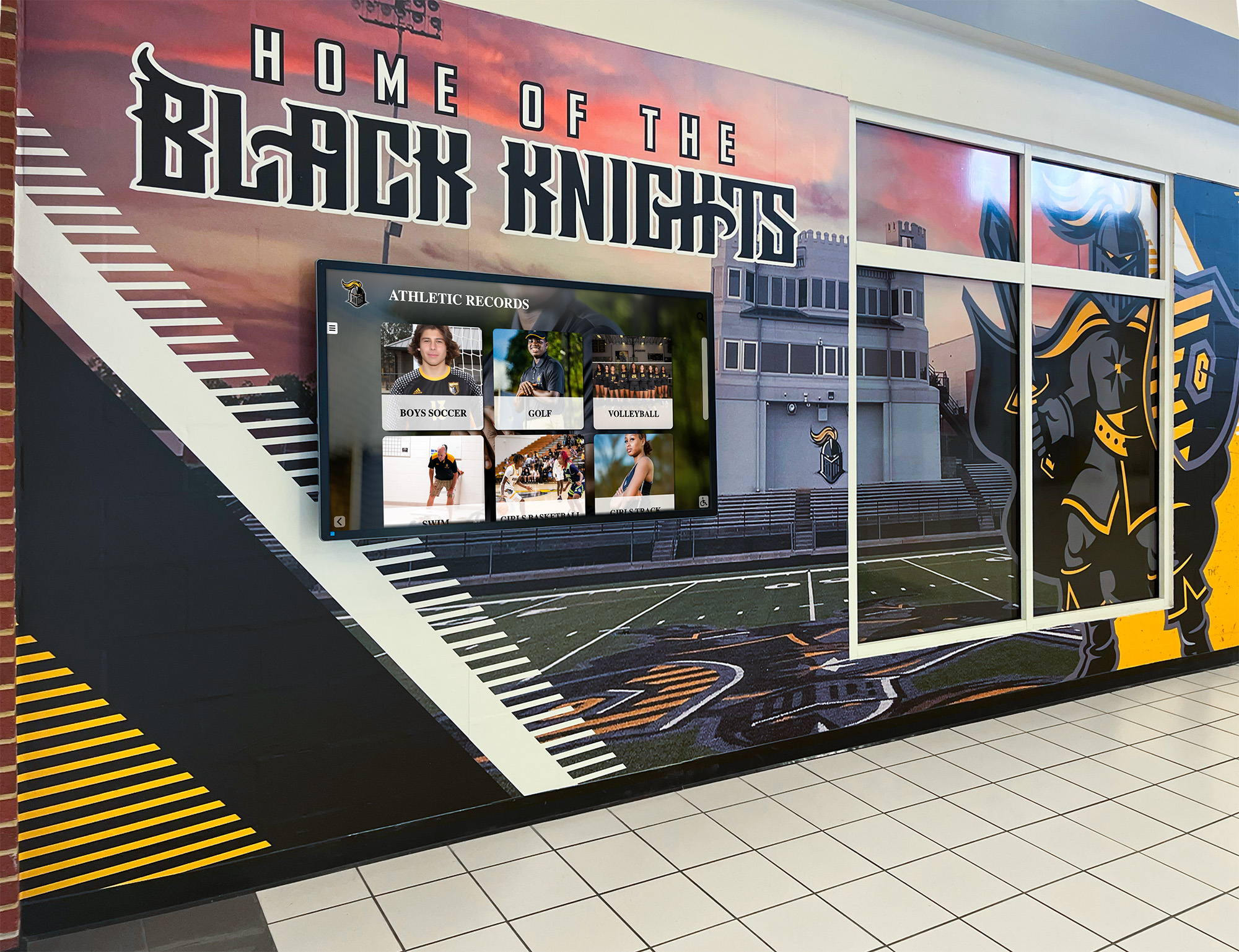
Conclusion: Transforming All-State Recognition Through Touch Board Technology
All-state athletic recognition represents celebration of the highest level of achievement in high school athletics. Athletes who earn these prestigious honors through years of dedication, exceptional performance, and competitive excellence deserve recognition matching the magnitude of their accomplishments—comprehensive celebration that preserves their legacy, honors their achievement, and inspires future athletes to pursue similar excellence.
Touch board technology transforms how schools celebrate all-state athletes by combining unlimited recognition capacity with rich multimedia storytelling, intuitive interactivity, and sophisticated content management. These modern recognition systems create lasting value across multiple dimensions: honoring individual athlete achievement with depth impossible through traditional plaques, inspiring current athletes by making elite performance visible and aspirational, demonstrating program excellence to prospective athletes and their families, strengthening alumni connections through ongoing recognition and engagement, and preserving institutional history for future generations.
The transition from traditional trophy cases and brief yearbook mentions to comprehensive interactive touch board recognition represents more than technological upgrade—it reflects evolved understanding of how effective recognition honors achievement while inspiring continued excellence. Every all-state athlete featured in touch board displays becomes part of an ongoing story about dedication, performance, and achievement that motivates current students, attracts talented recruits, and strengthens institutional culture around athletic excellence.
Core Implementation Principles:
- Begin with clear recognition goals aligned with institutional values and stakeholder needs
- Conduct comprehensive historical research documenting all-state athletes across program history
- Select commercial-grade hardware and specialized software designed for recognition purposes
- Develop compelling content featuring professional photography, complete statistics, and personal narratives
- Position displays strategically in high-traffic locations ensuring maximum visibility
- Establish sustainable workflows maintaining content currency across years
- Integrate all-state recognition with broader athletic celebration ecosystems
- Measure effectiveness through analytics, feedback, and impact assessment
- Commit to long-term investment viewing recognition as ongoing cultural priority
Schools ready to transform all-state athlete recognition should begin planning today. Research historical all-state athletes documenting your program’s tradition of excellence. Establish systematic processes for celebrating current and future all-state honorees. Evaluate technology platforms selecting solutions designed specifically for athletic recognition needs. Engage stakeholders building broad support for recognition investment. And commit to sustainable workflows ensuring recognition remains current and relevant for decades to come.
Solutions like Rocket Alumni Solutions provide comprehensive touch board platforms combining proven technology, intuitive management, and dedicated support specifically designed for schools celebrating athletic achievement. From initial planning through years of ongoing use, the right technology partner transforms recognition from administrative task into celebration centerpiece that truly honors and inspires excellence.
Ready to create all-state athlete recognition worthy of these exceptional achievements? Modern touch board recognition displays provide proven solutions honoring athletic excellence while building program culture where achievement flourishes. Your all-state athletes earned elite honors through years of dedication—they deserve recognition that matches their commitment and inspires the next generation to pursue similar excellence.




































